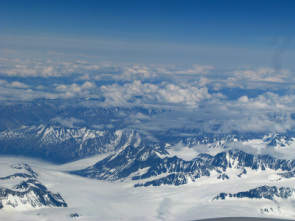After a cool and unsettled spring for most of the Western US, its finally summer. For
Arizona’s Prescott College that means an extended, ten-week, three-phase field based Wilderness Leadership Course. Prescott College Instructor Chris Marshall, M.A. and myself are leading the first phase, but we’re far from the arid sandstone wonderland right now, we’re talking the motherland of glaciers and big mountains: Alaska. 6 students will embark upon a 17 day journey through the legendary Chugach Mountains, climbing and skiing peaks along the way.
We’re doing a classic route known as the Eklutna traverse, which links several mountain huts and snow camps, over 3 major glaciers. Although the traverse can be done in substantially less time, we’ve set aside enough time for technical skill development and side projects, and there are no shortage of them: side glaciers, ski descents, peak climbing, and serac climbing. As the name implies, this field course focuses on wilderness leadership skills, particularly related to mountaineering, glaciers, and expedition style trips. Students run the expedition through a peer leadership model and are responsible for such topics as expedition planning, logistics, tour planning, navigation, leading climbing and skiing projects, risk management, and decision making. Intensive reflection and debriefing of leadership blocks synthesize theory and practice, enabling students to develop and refine their personal leadership style through a collaborative learning environment.
While traveling on glaciers and working on skills, we’ll also be keeping our eyes peeled for iceworms, which is a last minute ad-on to the trip. Believe it or not, small worms actually live on warmer coastal glaciers and consume bacteria and algae (fact check that) that grow in such areas. The study of glaciers and the effects of global warming are a widely known topic, but how does that effect the ecosystem on a glacier? Anchorage based Roman Dial is doing just that, studying these small creatures and tracking what kind and where they are located. Our trip is ideal for data collection: we’ll be covering lots of ground on several major glaciers, over a long period of time, and have 16 eyes keeping a lookout for worms. With little additional effort then we’re already putting into this trip, we can GPS, photograph, and take some samples, which will help contribute to a scientific study.
Right now its overcast and slightly drizzling: typical coastal weather. But that doesn’t seem to phase these 6 adventurers from Arizona; high spirits and typical pre-trip anxieties are motivating everybody to get on the trail and get started. So long for now, see you in 17 days!
Clark Corey
Sawtooth Mountain Guides
Stanley, ID www.sawtoothguides.com

